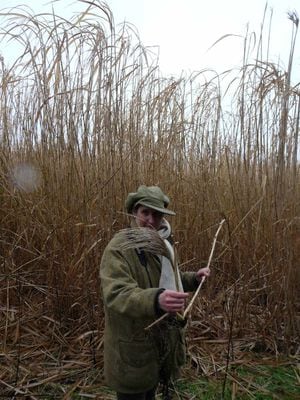Miscanthus crop offers low risk and high net margin
Farmers looking to offset the price volatility of traditional arable crops should take a serious look at miscanthus as a means of stabilising income on their farms.

The miscanthus supply chain manager Terravesta has been holding farm walks across the country to highlight the benefits of the crop, which has an important place on farms as a relatively low-risk and high-net-margin enterprise.

In Shropshire, a farm walk was hosted by Colin and Sheila Webb at The Buttery, Kynnerlsey, Telford where miscanthus has been grown for a decade.
Their daughter Helen Holman is marketing manager with Terravesta and she was joined by fellow experts from the firm to discuss husbandry and costs, and show visiting farmers the 400-acre crop which is now the farm's only enterprise.
Once planted, miscanthus can be left pretty much to its own devices and grows up to 14 feet before being harvested, usually between February and April.
Specialist contractors Wilson International Energy Crops do all the harvesting at The Buttery, and its Claas Jaguar 870 harvester with specialist header was on view waiting for the weather to clear before starting its rounds again.
"We have an enormous market to go at and we are keen to attract more growers," said miscanthus expert William Cracroft-Eley, chairman and founder of Terravesta and the co-founder of industry body Miscanthus Growers Ltd. "It is a long-term crop driven by the need to cut carbon emissions and greenhouse gas."
It has been identified that 350,000 hectares of perennial crops would be sustainable in the country and at the moment the primary markets for energy crops is to burn it.
Drax has already converted three power stations to biomass and there is demand from small-scale renewable heat projects including domestic and district schemes such as hospitals.
"All these opportunities come under competitive price pressures when oil is coming down in price but the crop is valuable in the long term as it is not at the whim of the volatility of the market," said Mr Cracroft-Eley.
Farmers can have a long-term contract at a fixed price as Terravesta is delivering market certainty with 10-year index-linked user and grower contracts. Over a 15-year period the average net margin has been £528 per hectare compared to an average arable margin of £550 per hectare (last year average arable margin was £47 per hectare)
"There is real volatility in cereal returns," he said.
Miscanthus is a C4 perennial grass planted from a rhizome, the first harvest comes after two or three years and the crop matures at five years. It is contract harvested and baled. It requires no fertiliser, minimal cultivation and minimal sprays.
The crop generates its own nutrients and if weeds are controlled hard pre emergence will require little weed control except perhaps in the first couple of years.
For Colin and Sheila Webb the switch to miscanthus has enabled them to continue farming with the knowledge that their children could manage the farm if something were to happen to Colin who has suffered some health problems.
"We started growing miscanthus 10 years ago under the Energy Crops Scheme," said Sheila.
Having previously grown cereals and sugar beet and then contract farmed arable crops, they wanted to make better use of the more marginal ground.
"We couldn't grow a large tonnage cheaply," she said. "We started with 50 acres of miscanthus and over four years built it up to 400 acres," she said.
Colin said that the crop is leaving them a profit of more than £100 an acre.
"No year has been the same but we have always managed to get a crop. We cut between February and the beginning of May when the cane is dead and before it starts growing again," he said.
Water and sunlight are the two key requirements of miscanthus and the crop will grow pretty well anywhere. At The Buttery the land ranges from pure red sand over sandstone to black peaty bottomed soils with sand at the top.
On one field of these soggy bottomed peats, two hectares were not harvested due to the wet 2014 spring and so there will be a double harvest this year, demonstrating the flexibility of the crop.
A wheat crop under the circumstances would have been lost, said Helen Holman.
After harvesting and baling, the crop is stored in a 140ft by 100ft, 3ft-high barn constructed two years ago until being collected by Terravesta, usually the following January.
The crop at The Buttery was planted under the Energy Crops Scheme. This Government planting incentive came to an end last year but there is still plenty of money to be made out of the crop without financial aid.
"We are quite happy that it's not the end for miscanthus," said Terravesta's farms advisory manager Andy Lee.
"Terravesta has slashed the establishment price to £425 per acre (£1,050 per hectare). Ten years ago this cost was £12,000 per hectare," he said.
The Terravesta package includes supply and delivery of quality-assured rhizomes (15,000 plants per hectare), loan of the precision planter plus pre and post planting agronomy advice.
The grower provides tractor and driver, hand labour for planting and a loader for the plants.
"There are still opportunities for farmers to plant miscanthus this year," Andy added.
Visit terravesta.com or email Andyl@terravesta.com





